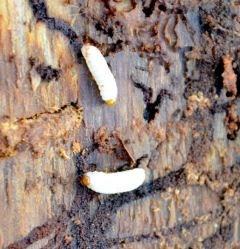Pilots have started taking to the air to help the Ministry of Forests, Lands and Natural Resource Operations assess the progress made on combatting an outbreak of the spruce beetle in the Omineca region.
Project manager Heather Wiebe said Tuesday an airplane has been deployed this week to check for evidence of the insect and general forest health.
Helicopters will then be used to do GPS surveys over the next week or two, followed by on-the-ground surveys to determine where any new attack has occurred.
A majority of the data should be in hand by mid-September and analyzed by October. That's when a summit on the spruce beetle - similar to those held for the mountain pine beetle in the past - will take place in Prince George.
"We're bringing in experts from across the province and North America to get a better understanding of what lessons there are to learn from spruce beetle," said Wiebe, who is also the resource manager in the Mackenzie Natural Resource District.
"But we're also bringing in folks from Nova Scotia and Alberta as they're finding populations are on the rise there and they're looking to B.C. to provide them with training and they're looking to us to be the experts which we are."
By then, staff might also have an idea of what it looks like in the northeast and Skeena.
"Conditions are ripe there for outbreaks as well, so we're looking at both of those regions to make sure they're prepared," Wiebe said.
In March, Minister of Forests, Lands and Natural Resource Operations Steve Thomson said the provincial government has committed $1 million for the fiscal year to deal with the outbreak.
Overhead flight surveys at that time had shown an increase in affected area to about 156,000 hectares from 7,653 hectares in 2013. But it remained limited to the eastern valleys of the Mackenzie timber supply area and northern portions of the Prince George timber supply area.
Setting "traps trees" has been a key strategy. A healthy spruce tree is cut down to mimic blowdown, the insect's "favourite food" and once infested enough, it's taken away to be milled in a hot-milling process that kills the live adults and the larvae.
"How even licensees are even decking their timber before it's removed from the block is beautiful," Wiebe said. "They're putting down the big-diameter spruce at the bottom of a pile and then shading it with longer, smaller diameter spruce and that's keeping it cooler under there so it's less likely for the beetles to fly.
"They're doing some really interesting things. You can see how the people who are out in the bush have experience and it's really going to be beneficial to us because of what they do."
The aim is to avoid what occurred in the 1980s when an outbreak in the Bowron area led to a massive logging operation, creating a clearcut so large it could be seen from space.



